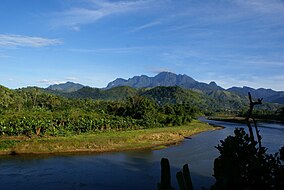
Back متنزه ماروجيجي الوطني Arabic Parque nacional de Marojejy AST Taman Nasional Marojejy BAN Parc Nacional de Marojejy Catalan Marojejy National Park CEB Národní park Marojejy Czech Nationalpark Marojejy German Parque nacional de Marojejy Spanish Marojejyn kansallispuisto Finnish Parc national de Marojejy French
| Marojejy National Park | |
|---|---|
 Marojejy Massif and the surrounding forests | |
Map of Madagascar | |
| Location | Sava region, Madagascar |
| Nearest city | Andapa and Sambava |
| Coordinates | 14°27′S 49°42′E / 14.450°S 49.700°E |
| Area | 55,500 ha (214 sq mi)[1] |
| Established | 1952 (Natural Reserve) 1998 (National Park)[2] |
| Governing body | Madagascar National Parks |
| World Heritage site | 2007 |
| www | |
Marojejy National Park (/məˈroʊdʒɛdʒiː/) is a national park in the Sava region of northeastern Madagascar. It covers 55,500 ha (214 sq mi) and is centered on the Marojejy Massif, a mountain chain that rises to an elevation of 2,132 m (6,995 ft). Access to the area around the massif was restricted to research scientists when the site was set aside as a strict nature reserve in 1952. In 1998, it was opened to the public when it was converted into a national park. It became part of the World Heritage Site known as the Rainforests of the Atsinanana in 2007. "Unique in the world, a place of dense, jungly rainforests, sheer high cliffs, and plants and animals found nowhere else on earth",[3] Marojejy National Park has received plaudits in the New York Times[4] and Smithsonian Magazine[5] for its natural beauty and rich biodiversity that encompasses critically endangered members of the silky sifaka. To that end, a global consortium of conservation organizations, including the Lemur Conservation Foundation, Duke Lemur Center and Madagascar National Parks, have sought to promote research and conservation programs in Marojejy National Park, neighboring Anjanaharibe-Sud Reserve and Antanetiambo Private Reserve, to protect the endemic flora and fauna that reside in northeastern Madagascar. In addition, these organizations have implemented a variety of community-based initiatives to mitigate human encroachment on the park, such as poaching and selective logging, by encouraging local communities to engage in afforestation and silvicultural initiatives to promote a sustainable alternative to mining, slash-and-burn agriculture, and wood collection.[6]
The wide range of elevations and rugged topography of the massif create diverse habitats that transition quickly with changes in altitude. Warm, dense rainforest can be found at lower elevations, followed by shorter forests at higher elevations, followed still by cloud forest, and topped near the peaks with the only remaining undisturbed mountain scrub in Madagascar. Better growing conditions for plants can be found on the eastern side of the mountains, which receives more rain than the western side. This habitat diversity lends itself to high levels of biodiversity. At least 118 species of bird, 148 species of reptile and amphibian, and 11 species of lemur are known to occur within Marojejy National Park. One of the lemurs, the silky sifaka (Propithecus candidus) is listed among "The World's 25 Most Endangered Primates". The helmet vanga (Euryceros prevostii) is considered the iconic bird species of the park.
One path leads from the entrance of the park to the summit. There are three camps along the route: Camp Mantella at 450 m (1,480 ft) in elevation in lowland rainforest, Camp Marojejia at 775 m (2,543 ft) at the transition between lowland and montane rain forest, and Camp Simpona at 1,250 m (4,100 ft) in the middle of the montane rainforest. Camp Simpona acts as a base camp for the trek to the summit, a route that stretches 2 km (1.2 mi) and can take up to four or five hours to traverse.
- ^ Cite error: The named reference
MNP_Marojejywas invoked but never defined (see the help page). - ^ Atkinson & Mathieu 2008, p. 2.
- ^ "Marojejy National Park - Introduction". www.marojejy.com. Retrieved 2021-01-07.
- ^ Vance, Erik (2020-10-26). "In Madagascar, Endangered Lemurs Find a Private Refuge". The New York Times. ISSN 0362-4331. Retrieved 2021-01-07.
- ^ Hendry, Erica R. "Saving the Silky Sifaka". Smithsonian Magazine. Retrieved 2021-01-07.
- ^ "Marojejy National Park - How You Can Help". www.marojejy.com. Retrieved 2021-01-07.
